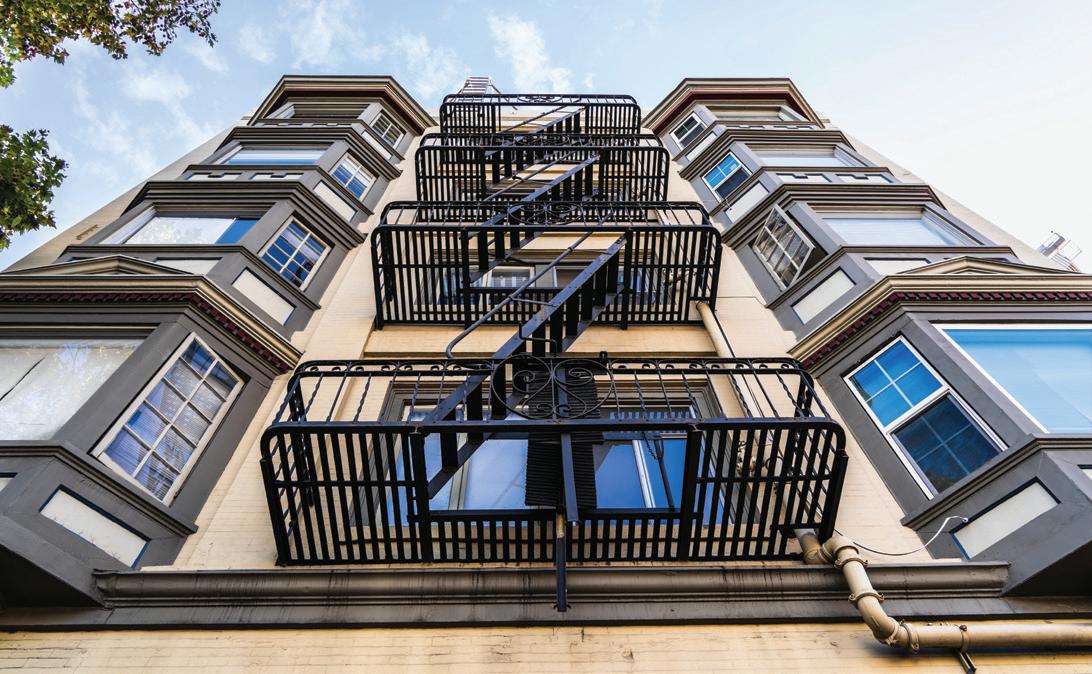
7 minute read
INFORM
INDUSTRY NEWS & MARKET TRENDS
EAST BAY MARKET REPORT
Advertisement
With improved COVID-19 risk-management, demand to spend life in the Bay Area has gone up. Multifamily assets are stabilizing after a tough year, and the East Bay recovery is outpacing that of San Francisco (for now). Sales, price-per-unit valuations and vacancy rates improved from COVID lows, albeit with the tradeoff of 10-15% rent reductions. Many investors learned hard lessons about taking a long-term perspective to residential income assets.
Thankfully, the chapter on ‘COVID Shock’ has appeared to close, but a series of choose-your-own-adventure plot twists await for different Bay Area submarkets. Narratives related to inflation, interest rates, tax reform, work-from-home trends and local/state/federal policy all present new opportunities to acquire or liquidate respective under- or over-valued assets.
Beginning with the top line, a look into the Zumper Rent Report as of July 28 shows that San Francisco still holds the top spot as the nation’s most expensive rental market with a *median* rent of $2,720 for a one-bedroom, down 15% from the previous year and up 2.6% from the previous month. Oakland sits at the seventh spot with a *median* one-bedroom rent of $2,000, down 9.9% from the previous year, with no change from the previous month.
There are a number of takeaways from these statistics. First, market price reductions tend to harm the least patient (or least capitalized) owners who filled vacancies during periods of low demand/pricing. Second, the median is the middle value observed, so owners who were patient and took time to ‘turn’ or renovate units have had the rare opportunity to adjust the renter profile and reposition for higher future rents. Third, sellers should not fill all vacancies before a sale, as potential buyers may see opportunities to invest in vacancies. Fourth, buyers will be wise to view multiple years of rent roll data and rates/concessions negotiated during leases that started during low-demand times.
A good illustration of owners seizing rent growth opportunities is 350 Hanover, a 19-unit listing our team brought to market in June. Ten days after the original listing, it received multiple offers above its asking price of $6.25M. In addition to excellent capital expenditures, the owners and property managers wisely converted extra space (e.g., dining rooms) into additional bedrooms for six of the units. We modeled a revenue growth scenario in the offering memorandum with both market rent increases and six more conversions. Reaching out to our clients with this investment thesis provided a healthy demand for 15-plus showings in the first two weeks.
If you don’t have the luxury of large unit layouts and have considered trading into buildings that reduce exposure to certain risks, you’ve likely tracked the work-from-home trend. Will the migration patterns of highly paid technology company employees reverse? Pre-pandemic, the Bay Area was the hub for employees of top companies like Google, Apple and others. Over the last year and a half, however, the typical workday for these employees has been quite different from the past—no commute and lots of virtual meetings.
After a year and a half of working from home, many are ready for a return to the aisles of pingpong breaks and catered lunches. But policies vary. Google, for example, has always created a pleasant work environment for its employees, and it is encouraging them to return to the office. However, an internal survey suggests that most Google employees would prefer to continue working from home. Despite this analysis of employee preference, post-pandemic, Google (which has pushed its voluntary work-from-home plan to October) expects that 60% of its employees will be in an office three days per week, 20% will work in new office locations and 20% will from home, according to an article on fastcompany.com. This difference in opinion between employee and employer seems to be a trend. The rise of the delta variant has thrown another curveball, with many employers hesitant to sign new leases with the uncertainty ahead, keeping vacancies high in the office sector.
In June, Apple told workers they should return to the office at least three days per week beginning in September. Some employees pushed back and even quit because of the lack of flexibility and freedom to choose for themselves. Due to rising COVID-19 cases, however, Apple reportedly has also pushed back its return-to-office date to October.
Uber will no longer be requiring employees to return to the workplace fulltime and developed a ‘hybrid model’ instead. According to the fastcompany.com article, Uber will allow employees to work from home two days per week but will expect them to be in the office the other three. There is a potential that these plans will become the concrete future of work. But it’s hard to imagine deep connections to form among ambitious professionals without steady in-person interaction and the serendipity that comes with proximity.
If Bay Area owners are betting on a slower recovery and are considering a ‘flight to quality,’ there can be merit to preserving principal and sacrificing margins for risk hedges. For example, reducing margins can be traded for qualities such as optionality or a new renter profile that may deliver higher margins down the line. In Berkeley, a

14-unit property at 2410 Dwight (listed at $3.75M, 5.6% cap rate in May) demonstrated multiple risk hedges despite Berkeley’s lower operating margins (higher fees, etc.). First, the building is three blocks south of the best public school in the country, so it has a stable source of demand. Second, student turnover provides an excellent inflation hedge, as owners can raise prices with rising costs. Third, this building has two units that are in between renovations, so the owner monetized them as monthly rentals, generating income without locking them up via a renter. Within 10 days of being on the market, the property hosted 17 tours, and the owners of 2410 Dwight received five offers.
2-4 UNITS
For 2-4 unit multifamily buildings in Oakland, Berkeley and Alameda, markets in Q2 2021 posted a two-year high of 160 transactions, closed totaling $191M in value. Extraordinarily, sales of 2-4 units in Oakland more than doubled from $58M in Q1 2021 to $126M in Q2 2021 while Berkeley nearly doubled from $26M in Q1 2021 to $47M in Q2 2021. Alameda rose from $10.1M in Q1 2021 to a two year high of $17.3M in sales in Q2 2021. So far, Q3 2021 is showing no signs of slowing.
5+ UNITS
In the commercially financed portion of the market, we’re eager to see if the East Bay will continue its 10-year trend of being more stable and faster-growing in value than San Francisco. As reported in our last quarterly market update, the 10-year trend in price-per-unit valuations has been growing at 8.1% per year in the East Bay, while San Francisco has seen 5.9% over the same period. The change in priceper-unit valuations from Q1 2021 to Q2 2021 showed signs of this possibly changing, as price-per-unit values grew from $602K to $624K in SF, a 3.6% improvement, while in the East Bay this grew from $381K to $392K, a 3% increase. The East Bay remains more stable as vacancy dropped from 8.1% to 7.3%, compared to San Francisco’s drop from 10.2% to 8.6%. For both regions, sales volumes were relatively flat or modest compared to past quarters.
Looking ahead, we are eager to see how pronounced inflation trends will be, as inflation has been historically managed by increasing federal reserve policies that effectively raise interest rates. Despite continued purchasing of assets and a near-zero federal funds rate target, more and more Federal Reserve leaders have mentioned 2022 as the beginning of potential rate hikes. A rate hike would effectively raise the returns of all assets across risk levels, effectively lowering values of all assets, as asset/wealth managers would sell riskier assets to buy less risky assets and theoretically generate the same rate of return. Additionally, we are looking for market trends related to the eviction moratorium that President Biden has extended to October 3, as this prevents asset owners from managing renter risks. When the slower summer months fade away, the fall/winter quarters look set to offer important new data points that can support or weaken our long-term investment views.
Chappell Team has been serving the East Bay multifamily market for 16+ years helping clients acquire, dispose, trade and evaluate multifamily properties. Please reach out for any of your commercial real estate needs.









